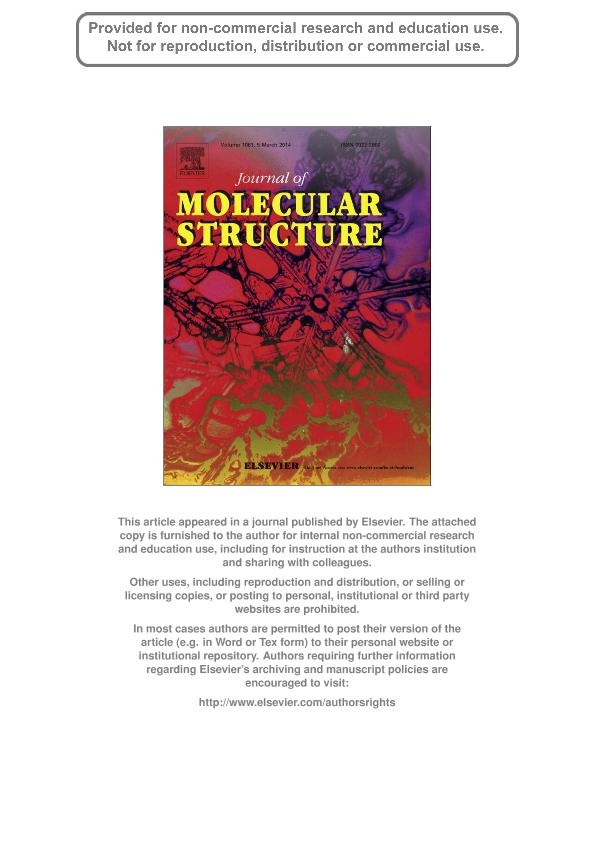Mostrar el registro sencillo del ítem
dc.contributor.author
Russo, Marcos Guillermo

dc.contributor.author
Vega Hissi, Esteban Gabriel

dc.contributor.author
Rizzi, Alberto Claudio
dc.contributor.author
Brondino, Carlos Dante

dc.contributor.author
Salinas Ibañez, Angel G.
dc.contributor.author
Vega, Alba Edith
dc.contributor.author
Silva, Humberto de Jesus

dc.contributor.author
Mercader, Roberto Carlos

dc.contributor.author
Narda, Griselda Edith

dc.date.available
2016-05-24T18:53:07Z
dc.date.issued
2014-01
dc.identifier.citation
Russo, Marcos Guillermo; Vega Hissi, Esteban Gabriel; Rizzi, Alberto Claudio; Brondino, Carlos Dante; Salinas Ibañez, Angel G.; et al.; Synthesis, physicochemical characterization, DFT calculation and biological activities of Fe(III) and Co(II)–omeprazole complexes. Potential application in the Helicobacter pylori eradication; Elsevier; Journal of Molecular Structure; 1061; 1-2014; 5-13
dc.identifier.issn
0022-2860
dc.identifier.uri
http://hdl.handle.net/11336/5814
dc.description.abstract
The reaction between the antiulcer agent omeprazole (OMZ) with Fe(III) and Co(II) ions was studied, observing a high ability to form metal complexes. The isolated microcrystalline solid complexes were characterized by elemental analysis, X-ray powder diffraction (XRPD), Scanning Electron Microscopy (SEM), magnetic measurements, thermal study, FTIR, UV–Visible, Mössbauer, electronic paramagnetic resonance (EPR), and DFT calculations. The metal–ligand ratio for both complexes was 1:2 determined by elemental and thermal analysis. FTIR spectroscopy showed that OMZ acts as a neutral bidentate ligand through the pyridinic nitrogen of the benzimidazole ring and the oxygen atom of the sulfoxide group, forming a five-membered ring chelate. Electronic, Mössbauer, and EPR spectra together with magnetic measurements indicate a distorted octahedral geometry around the metal ions, where the coordination sphere is completed by two water molecules. SEM and XRPD were used to characterize the morphology and the crystal nature of the complexes. The most favorable conformation for the Fe(III)–OMZ and Co(II)–OMZ complexes was obtained by DFT calculations by using B3LYP/6-31G(d)&LanL2DZ//B3LYP/3-21G(d)&LanL2DZ basis set. Studies of solubility along with the antibacterial activity against Helicobacter pylori for OMZ and its Co(II) and Fe(III) complexes are also reported. Free OMZ and both metal complexes showed antibacterial activity against H. pylori. Co(II)–OMZ presented a minimal inhibitory concentration ∼32 times lower than that of OMZ and ∼65 lower than Fe(III)–OMZ, revealing its promising potential use for the treatment of gastric pathologies associated with the Gram negative bacteria. The morphological changes observed in the cell membrane of the bacteria after the incubation with the metal-complexes were also analyzed by SEM microscopy. The antimicrobial activity of the complexes was proved by the viability test.
dc.format
application/pdf
dc.language.iso
eng
dc.publisher
Elsevier

dc.rights
info:eu-repo/semantics/openAccess
dc.rights.uri
https://creativecommons.org/licenses/by-nc-nd/2.5/ar/
dc.subject
Metal-Drug Complexes
dc.subject
Omeprazole
dc.subject
Iron(Iii)
dc.subject
Cobalt(Ii)
dc.subject.classification
Química Inorgánica y Nuclear

dc.subject.classification
Ciencias Químicas

dc.subject.classification
CIENCIAS NATURALES Y EXACTAS

dc.title
Synthesis, physicochemical characterization, DFT calculation and biological activities of Fe(III) and Co(II)–omeprazole complexes. Potential application in the Helicobacter pylori eradication
dc.type
info:eu-repo/semantics/article
dc.type
info:ar-repo/semantics/artículo
dc.type
info:eu-repo/semantics/publishedVersion
dc.date.updated
2016-05-16T20:06:45Z
dc.journal.volume
1061
dc.journal.pagination
5-13
dc.journal.pais
Países Bajos

dc.journal.ciudad
Amsterdam
dc.description.fil
Fil: Russo, Marcos Guillermo. Consejo Nacional de Investigaciones Científicas y Técnicas. Centro Científico Tecnológico San Luis. Instituto de Investigaciones en Tecnología Química; Argentina
dc.description.fil
Fil: Vega Hissi, Esteban Gabriel. Consejo Nacional de Investigaciones Científicas y Técnicas. Centro Científico Tecnológico San Luis. Instituto Multidisciplinario de Investigaciones Biológicas de San Luis; Argentina
dc.description.fil
Fil: Rizzi, Alberto Claudio. Universidad Nacional del Litoral. Facultad de Bioquímica y Ciencias Biológicas. Departamento de Física; Argentina
dc.description.fil
Fil: Brondino, Carlos Dante. Universidad Nacional del Litoral. Facultad de Bioquímica y Ciencias Biológicas. Departamento de Física; Argentina
dc.description.fil
Fil: Salinas Ibañez, Angel G.. Universidad Nacional de San Luis. Facultad de Química, Bioquímica y Farmacia; Argentina
dc.description.fil
Fil: Vega, Alba Edith. Universidad Nacional de San Luis. Facultad de Química, Bioquímica y Farmacia; Argentina
dc.description.fil
Fil: Silva, Humberto de Jesus. Universidad Nacional de San Luis. Facultad de Química, Bioquímica y Farmacia; Argentina
dc.description.fil
Fil: Mercader, Roberto Carlos. Universidad Nacional de la Plata. Facultad de Ciencias Exactas; Argentina
dc.description.fil
Fil: Narda, Griselda Edith. Consejo Nacional de Investigaciones Científicas y Técnicas. Centro Científico Tecnológico San Luis. Instituto de Investigaciones en Tecnología Química; Argentina
dc.journal.title
Journal of Molecular Structure

dc.relation.alternativeid
info:eu-repo/semantics/altIdentifier/url/http://www.sciencedirect.com/science/article/pii/S0022286014000039
dc.relation.alternativeid
info:eu-repo/semantics/altIdentifier/doi/http://dx.doi.org/10.1016/j.molstruc.2013.12.073
dc.relation.alternativeid
info:eu-repo/semantics/altIdentifier/doi/10.1016/j.molstruc.2013.12.073
Archivos asociados
